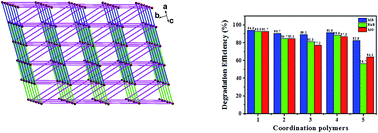A series of five-coordinated copper coordination polymers for efficient degradation of organic dyes under visible light irradiation†
Abstract
The copper(II) coordination polymers {[Cu4(OH)2(bix)2(1,2,4-btc)2(H2O)2]·3H2O}n (1), [Cu2(bix)(ip)2]n (2), [Cu2(bix)(Meip)2]n (3), {[Cu2(bix)(pbda)2]·H2O}n (4) and {[Cu2(bix)1.5(2,5-pydc)2(H2O)]·2H2O}n (5) were synthesized using the hydrothermal method (bix = 1,4-bis(2-methyl-imidazol-1-ylmethyl)benzene, 1,2,4-btc = 1,2,4-benzenetricarboxylate, ip = isophthalate, Meip = 5-methyl-isophthalate, pbda = 1,4-benzenediacatate, 2,5-pydc = 2,5-pyridine-dicarboxylate). 1 exhibits a (3,5)-connected 2D network with the point symbol of (42·6)(42·67·8) based on the [Cu2(μ-OH)] dimer. 2 exhibits the 2-fold interpenetrating three-dimensional pcu network based on the [Cu2(COO)4] dimers. 3 exhibits the 2-fold interpenetrating three-dimensional pcu network based on the [Cu2(COO)2] and [Cu2(COO)4] dimers. 4 shows an unusual 6-connected self-catenated 3D network with the point symbol of (44·610·8) based on [Cu2(COO)4] dimers. 5 exhibits a (3,4)-connected 2D network with the point symbol of (42·6)(42·63·8). 1–5 are semiconducting in nature, with Eg of 2.21 eV (1), 2.35 eV (2), 2.41 eV (3), 2.13 eV (4), and 2.62 eV (5). 1–5 are highly efficient and universal photocatalysts for the degradation of the organic dyes methylene blue (MB), rhodamine B (RhB) and methyl orange (MO) under visible light irradiation, and are very stable and easily separated from the reaction system for reuse. This work shows that the coordinated unsaturated copper coordination polymers should be very promising photocatalysts for degradation of organic dyes.



 Please wait while we load your content...
Please wait while we load your content...